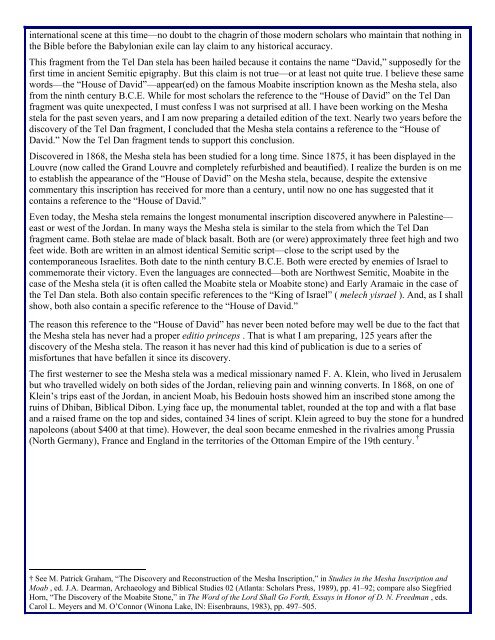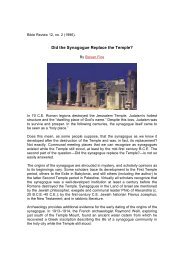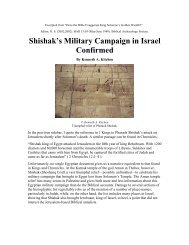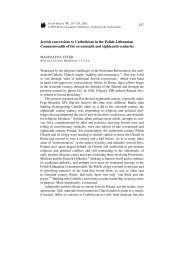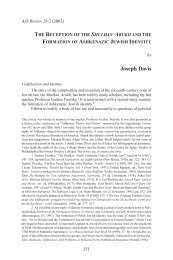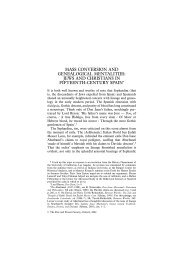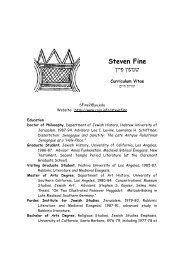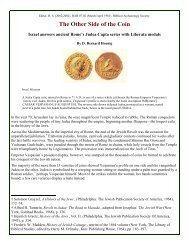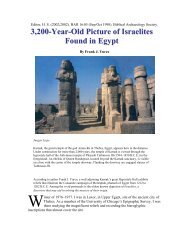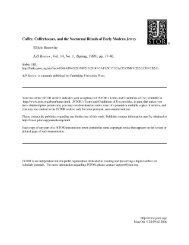“House of David” Restored in Moabite Inscription
“House of David” Restored in Moabite Inscription
“House of David” Restored in Moabite Inscription
Create successful ePaper yourself
Turn your PDF publications into a flip-book with our unique Google optimized e-Paper software.
<strong>in</strong>ternational scene at this time—no doubt to the chagr<strong>in</strong> <strong>of</strong> those modern scholars who ma<strong>in</strong>ta<strong>in</strong> that noth<strong>in</strong>g <strong>in</strong><br />
the Bible before the Babylonian exile can lay claim to any historical accuracy.<br />
This fragment from the Tel Dan stela has been hailed because it conta<strong>in</strong>s the name “David,” supposedly for the<br />
first time <strong>in</strong> ancient Semitic epigraphy. But this claim is not true—or at least not quite true. I believe these same<br />
words—the <strong>“House</strong> <strong>of</strong> <strong>David”</strong>—appear(ed) on the famous <strong>Moabite</strong> <strong>in</strong>scription known as the Mesha stela, also<br />
from the n<strong>in</strong>th century B.C.E. While for most scholars the reference to the <strong>“House</strong> <strong>of</strong> <strong>David”</strong> on the Tel Dan<br />
fragment was quite unexpected, I must confess I was not surprised at all. I have been work<strong>in</strong>g on the Mesha<br />
stela for the past seven years, and I am now prepar<strong>in</strong>g a detailed edition <strong>of</strong> the text. Nearly two years before the<br />
discovery <strong>of</strong> the Tel Dan fragment, I concluded that the Mesha stela conta<strong>in</strong>s a reference to the <strong>“House</strong> <strong>of</strong><br />
David.” Now the Tel Dan fragment tends to support this conclusion.<br />
Discovered <strong>in</strong> 1868, the Mesha stela has been studied for a long time. S<strong>in</strong>ce 1875, it has been displayed <strong>in</strong> the<br />
Louvre (now called the Grand Louvre and completely refurbished and beautified). I realize the burden is on me<br />
to establish the appearance <strong>of</strong> the <strong>“House</strong> <strong>of</strong> <strong>David”</strong> on the Mesha stela, because, despite the extensive<br />
commentary this <strong>in</strong>scription has received for more than a century, until now no one has suggested that it<br />
conta<strong>in</strong>s a reference to the <strong>“House</strong> <strong>of</strong> David.”<br />
Even today, the Mesha stela rema<strong>in</strong>s the longest monumental <strong>in</strong>scription discovered anywhere <strong>in</strong> Palest<strong>in</strong>e—<br />
east or west <strong>of</strong> the Jordan. In many ways the Mesha stela is similar to the stela from which the Tel Dan<br />
fragment came. Both stelae are made <strong>of</strong> black basalt. Both are (or were) approximately three feet high and two<br />
feet wide. Both are written <strong>in</strong> an almost identical Semitic script—close to the script used by the<br />
contemporaneous Israelites. Both date to the n<strong>in</strong>th century B.C.E. Both were erected by enemies <strong>of</strong> Israel to<br />
commemorate their victory. Even the languages are connected—both are Northwest Semitic, <strong>Moabite</strong> <strong>in</strong> the<br />
case <strong>of</strong> the Mesha stela (it is <strong>of</strong>ten called the <strong>Moabite</strong> stela or <strong>Moabite</strong> stone) and Early Aramaic <strong>in</strong> the case <strong>of</strong><br />
the Tel Dan stela. Both also conta<strong>in</strong> specific references to the “K<strong>in</strong>g <strong>of</strong> Israel” ( melech yisrael ). And, as I shall<br />
show, both also conta<strong>in</strong> a specific reference to the <strong>“House</strong> <strong>of</strong> David.”<br />
The reason this reference to the <strong>“House</strong> <strong>of</strong> <strong>David”</strong> has never been noted before may well be due to the fact that<br />
the Mesha stela has never had a proper editio pr<strong>in</strong>ceps . That is what I am prepar<strong>in</strong>g, 125 years after the<br />
discovery <strong>of</strong> the Mesha stela. The reason it has never had this k<strong>in</strong>d <strong>of</strong> publication is due to a series <strong>of</strong><br />
misfortunes that have befallen it s<strong>in</strong>ce its discovery.<br />
The first westerner to see the Mesha stela was a medical missionary named F. A. Kle<strong>in</strong>, who lived <strong>in</strong> Jerusalem<br />
but who travelled widely on both sides <strong>of</strong> the Jordan, reliev<strong>in</strong>g pa<strong>in</strong> and w<strong>in</strong>n<strong>in</strong>g converts. In 1868, on one <strong>of</strong><br />
Kle<strong>in</strong>’s trips east <strong>of</strong> the Jordan, <strong>in</strong> ancient Moab, his Bedou<strong>in</strong> hosts showed him an <strong>in</strong>scribed stone among the<br />
ru<strong>in</strong>s <strong>of</strong> Dhiban, Biblical Dibon. Ly<strong>in</strong>g face up, the monumental tablet, rounded at the top and with a flat base<br />
and a raised frame on the top and sides, conta<strong>in</strong>ed 34 l<strong>in</strong>es <strong>of</strong> script. Kle<strong>in</strong> agreed to buy the stone for a hundred<br />
napoleons (about $400 at that time). However, the deal soon became enmeshed <strong>in</strong> the rivalries among Prussia<br />
(North Germany), France and England <strong>in</strong> the territories <strong>of</strong> the Ottoman Empire <strong>of</strong> the 19th century. †<br />
† See M. Patrick Graham, “The Discovery and Reconstruction <strong>of</strong> the Mesha <strong>Inscription</strong>,” <strong>in</strong> Studies <strong>in</strong> the Mesha <strong>Inscription</strong> and<br />
Moab , ed. J.A. Dearman, Archaeology and Biblical Studies 02 (Atlanta: Scholars Press, 1989), pp. 41–92; compare also Siegfried<br />
Horn, “The Discovery <strong>of</strong> the <strong>Moabite</strong> Stone,” <strong>in</strong> The Word <strong>of</strong> the Lord Shall Go Forth, Essays <strong>in</strong> Honor <strong>of</strong> D. N. Freedman , eds.<br />
Carol L. Meyers and M. O’Connor (W<strong>in</strong>ona Lake, IN: Eisenbrauns, 1983), pp. 497–505.


